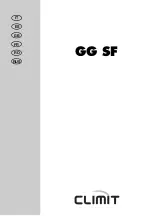
6 720 610 576 GB (02.05)
Installation
17
3.9.1
Siting the Flue Terminal
The flue must be installed in accordance with
BS 5440:1 and the Building Regulations. Flue terminals
in carports and under balconies are to be avoided.
The terminal must be positioned so that it does not
cause an obstruction nor the combustion products a
nuisance. See fig. 14 and table 9.
The terminal will, at times, give out a plume of water
vapour and consideration must be given to this when
choosing a terminal position. Keep clear of security
lighting, activated by passive infra-red sensing heads.
If the terminal is less than 2 m above a surface to which
people have access then a guard must be fitted. The
guard must be evenly spaced about the terminal with a
space of 50 mm in each direction and fixed with plated
screws.
A guard Type K2 for the standard horizontal flue, can be
obtained from Tower Flue Components, Vale Rise, Ton-
bridge TN9 1TB.
Fig. 14
Minimum dimensions of flue terminal positions (all types) (see fig. 14)
Dimension
Terminal Position (kW input expressed in net)
Balanced flues room sealed: Fanned draught
A
1)
Directly below an opening, air brick, opening windows, etc.
300 mm
Above an opening, air brick, opening window, etc.
300 mm
C
Horizontally to an opening, air brick, opening window, etc.
300 mm
D
Below gutters, soil pipes or drain pipes
75 mm
E
Below eaves
200 mm
F
Below balconies or car port roof
200 mm
G
From a vertical drain pipe or soil pipe
150 mm
H
From an internal or external corner
300 mm
I
Above ground roof or balcony level
300 mm
J
From a surface facing the terminal
600 mm
K
From a terminal facing the terminal
1200 mm
L
From an opening in the car port (e. g. door, window) into the dwelling
1200 mm
M
Vertically from a terminal on the same wall
1500mm
N
Horizontally from a terminal on the same wall
300 mm
O
From the wall on which the terminal is mounted
Not applicable
P
From a vertical structure on the roof
Not applicable
Q
Above intersection with roof
Not applicable
Table 9
1)
In addition, the terminal should not be nearer than 150 mm (fanned draught) to an opening in the building fabric formed for the pur-
pose of accommodating a built-in element such as a window frame.
















































